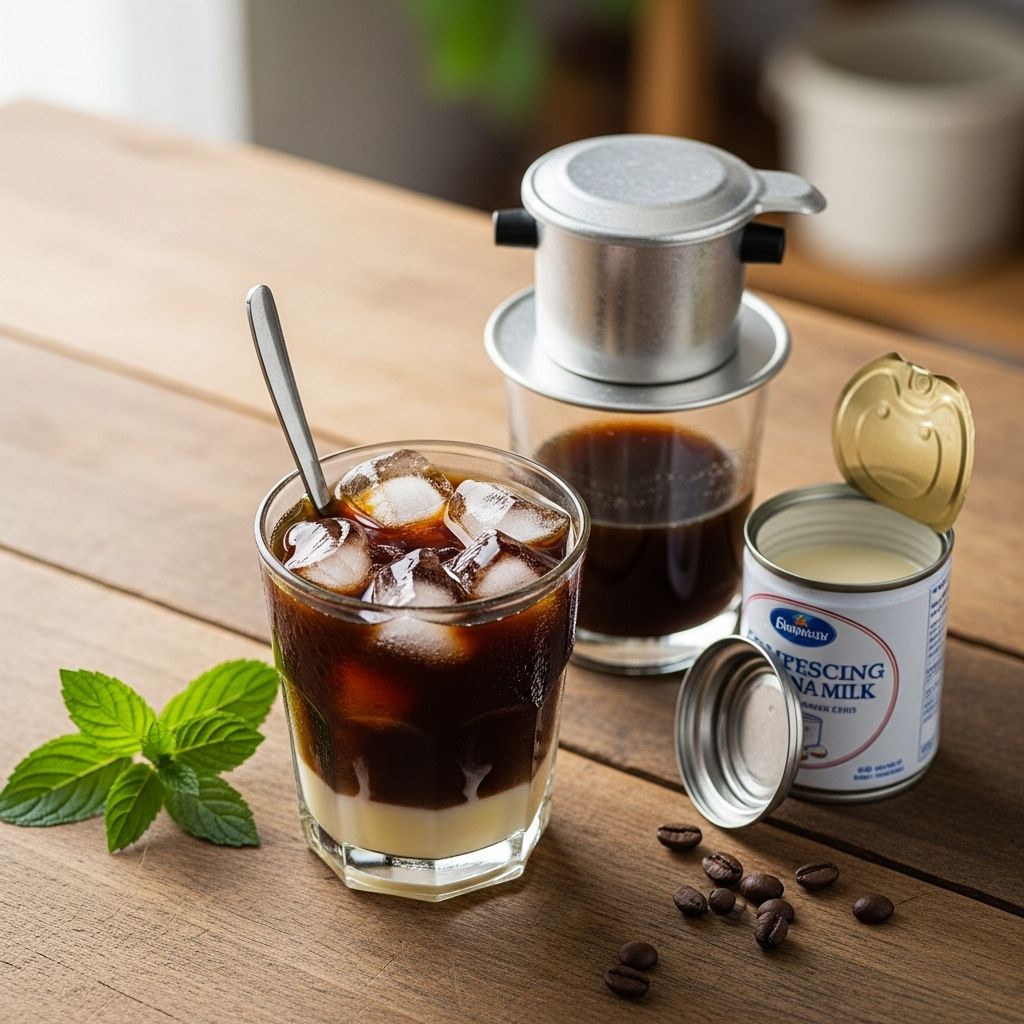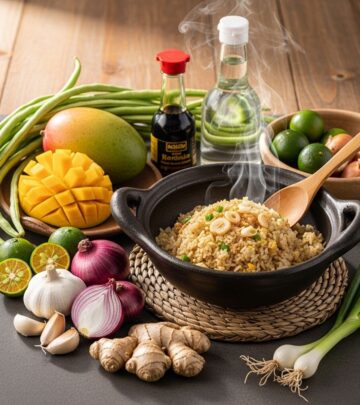Vietnamese Iced Coffee Recipe: Authentic & Comprehensive Guide
Discover the secrets, history, and brew methods behind the bold and beloved Vietnamese iced coffee—creamy, intense, and unforgettable.

Image: HearthJunction Design Team
Vietnamese Iced Coffee: The Ultimate Guide to Cà Phê Sữa Đá
Vietnamese iced coffee—known as Cà Phê Sữa Đá—is an iconic drink beloved for its intense, robust flavor and smooth, creamy sweetness. Served over ice and made with strong coffee and thick sweetened condensed milk, it offers a refreshing and rich pick-me-up that has won coffee lovers worldwide. Whether enjoyed in a street-side café in Hanoi or recreated in your kitchen, Vietnamese iced coffee is a testament to the country’s vibrant café culture and ingenious brewing traditions.
What is Vietnamese Iced Coffee?
Vietnamese iced coffee is a beverage that combines strong, slow-brewed coffee with sweetened condensed milk, poured over ice. Its uniquely bold, sweet, and creamy profile is achieved through the use of robusta coffee beans and a special brewing process. Unlike many Western iced coffees, which are often watery, Cà Phê Sữa Đá is rich, thick, and unapologetically intense, balanced perfectly by the velvety sweetness of condensed milk.
Beyond its taste, it reflects centuries of Vietnamese history, adaptation, and a love of social coffee culture.
In Vietnam, Cà Phê Sữa Đá is a staple at roadside stalls, trendy cafés, and in households, enjoyed leisurely or taken as a mid-afternoon boost. Its popularity has spread across the globe, making it a must-try for anyone serious about coffee.
Ingredients for Authentic Vietnamese Iced Coffee
- Dark Roast Coffee: Traditionally, Vietnamese coffee uses robusta beans, which yield an especially strong, bold brew. However, dark-roast arabica or espresso can be substituted if you do not have access to robusta coffee.
- Sweetened Condensed Milk: This thick, sugary milk is an essential component, providing sweetness and creamy richness. Brands like Longevity or Eagle are popular choices in Vietnam.
- Hot Water: Near-boiling water is needed for extraction.
- Ice Cubes: A tall glass filled with ice chills the hot coffee instantly, creating the signature cold, refreshing drink.
| Ingredient | Amount (for 1 serving) |
|---|---|
| Dark roast ground coffee | 2 tablespoons |
| Sweetened condensed milk | 2 tablespoons (or to taste) |
| Hot water | 4–6 ounces |
| Ice cubes | 4–5 cubes |
Special Equipment: The Vietnamese Phin Filter
One of the distinguishing features of Vietnamese iced coffee is the use of the phin filter, a simple yet effective Vietnamese coffee press.
What is a Phin Filter?
- The phin is a small, metal drip filter comprised of a brew chamber, a gravity or screw-down press, and a lid.
- It is placed on top of a cup or glass. Coffee grounds are added inside, hot water is poured over, and the phin slowly drips concentrated coffee into the glass below.
- The process is slower than most Western methods, but the resulting brew is remarkably strong and flavorful.
The phin filter is easy to use and sustainable, contributing zero waste and requiring no paper filters.
Step-by-Step: How to Make Vietnamese Iced Coffee
Traditional Method (with Phin Filter)
- Measure and Prepare: Place 2 tablespoons of sweetened condensed milk in the bottom of a tall glass.
- Add Coffee: Add 2 tablespoons of ground dark roast coffee to your phin filter. Lightly tamp down with the press disk.
- Bloom the Coffee: Pour a small amount (about 2 tablespoons) of hot water over the grounds to let them “bloom” for 30 seconds. This helps release essential flavors and aromas.
- Brew: Fill the phin filter with boiling water to the brim, cover with the lid, and allow the coffee to drip slowly into the glass over about 4–5 minutes. The dripping should be steady but not too fast.
- Mix: Once all the coffee has dripped through, stir the mixture until the condensed milk is fully dissolved.
- Serve Over Ice: Fill a tall serving glass with ice cubes. Pour the sweetened coffee over the ice. Stir briskly and enjoy!
Quick Espresso Method
- Brew 2 ounces of espresso (using an espresso machine or stovetop espresso maker).
- Pour hot espresso over 2 tablespoons of sweetened condensed milk, stir to combine.
- Pour the mixture into a glass filled with ice, stir again, and serve.
- This is an efficient way to prepare Vietnamese iced coffee in large batches or when short on time.
Tips for the Best Vietnamese Iced Coffee
- Choose Robust Coffee: Aim for dark roast and, if possible, Vietnamese-grown robusta for the most authentic taste.
- Don’t Rush the Brew: The traditional phin method requires patience. The slow drip intensifies the flavor, so resist the urge to speed things up.
- Quality Condensed Milk: Use real sweetened condensed milk, not evaporated milk. Adjust the amount to suit your sweetness preference.
- Experiment with Ratios: Some prefer their coffee stronger, others sweeter. Feel free to increase or decrease the amount of coffee or condensed milk to match your taste.
- Serve Immediately: Vietnamese iced coffee is best enjoyed immediately after pouring over ice—this ensures it’s icy cold and at peak flavor.
Brewing Methods Comparison
| Method | Time | Flavor Profile | Best For |
|---|---|---|---|
| Phin Filter (Traditional) | 4–5 minutes | Intense, complex, slightly smoky | Traditionalists, slow mornings |
| Espresso Machine | ~1 minute | Bold, creamy, bright | Quick preparation, large batches |
| French Press | 4–5 minutes | Smooth, rich, full-bodied | Adapted Western method |
Origins and Coffee Culture in Vietnam
Coffee was introduced to Vietnam by French colonists in the 19th century. Over time, the Vietnamese developed their unique coffee style in response to limited access to fresh milk, turning to sweetened condensed milk as an ingenious alternative. This created the signature thick and sweet coffee that sets Vietnamese coffee apart.
Today, Vietnam is the world’s second-largest coffee producer. Coffee culture thrives in Vietnam, where locals gather at café stalls for slow mornings or quick breaks, enjoying coffee’s robust flavor and the community that comes with it.
Variations of Vietnamese Coffee
- Cà Phê Sữa Nóng: The hot version, served without ice for a warming, comforting treat.
- Cà Phê Đen: Black Vietnamese coffee, typically made without milk or sugar, showcasing the boldness of the robusta beans.
- Cà Phê Trứng: Egg coffee, where beaten egg yolk and sweetened condensed milk are whipped into a creamy foam and floated over strong coffee—a decadent Hanoi specialty.
- Coconut Vietnamese Iced Coffee: Blended with coconut milk or cream for a tropical twist.
Why Use Sweetened Condensed Milk?
Sweetened condensed milk has become synonymous with Vietnamese iced coffee. It serves multiple roles:
- Sweetness: Adds a rich, sugary taste that balances the robust coffee.
- Creaminess: Gives the drink its thick, luxurious mouthfeel.
- Historical Context: In the past, fresh milk was scarce and didn’t keep well in Vietnam’s hot climate; sweetened condensed milk was an affordable and shelf-stable alternative.
This combination is now a defining trait of the drink, setting it apart from other global coffee styles.
Serving Suggestions and Pairings
- Serve Cà Phê Sữa Đá over a tall glass of ice for a refreshing treat.
- Pair with Vietnamese pastries such as bánh mì or coconut jellies.
- Enjoy with a savory breakfast for an energizing start to your day.
- Try using Vietnamese iced coffee as a base for coffee ice cream, cocktails, or blended frappés.
Error-Proofing Common Mistakes
- Too Weak or Watery: Use enough grounds, and avoid over-diluting with hot water. The coffee should be concentrated before mixing with ice.
- Too Sweet: Adjust the condensed milk to your taste. Start with less, and add more if needed.
- Incorrect Grind: Use a medium to coarse grind for phin filters; fine grounds may clog the filter and brew unevenly.
- Low-Quality Coffee: Invest in quality beans for authentic, bold flavor.
Frequently Asked Questions (FAQs)
Q: Can I make Vietnamese iced coffee without a phin filter?
A: Yes, while the phin is traditional, you can use a French press or espresso maker to brew strong coffee, then mix with condensed milk and pour over ice. The taste will be slightly different but still delicious.
Q: Is Vietnamese iced coffee very caffeinated?
A: Yes, robusta beans have higher caffeine content than arabica, making Vietnamese iced coffee quite strong. Adjust the amount of coffee or use arabica to reduce caffeine.
Q: Can I make it dairy-free?
A: Substitute sweetened condensed coconut milk or another non-dairy alternative for a vegan-friendly version, but expect a different flavor profile.
Q: What is the difference between Cà Phê Sữa Đá and Thai iced coffee?
A: Thai iced coffee typically includes spices and evaporated milk, while Vietnamese iced coffee is simpler and relies purely on robust coffee and sweetened condensed milk.
Q: How do I store leftover brewed coffee?
A: Brewed coffee can be stored in the fridge for up to 2 days. Mix with condensed milk only when ready to serve over ice for best taste and texture.
Conclusion: Why You Should Try Vietnamese Iced Coffee
Vietnamese iced coffee stands out as a testament to Vietnam’s ingenuity and coffee culture. Its bold flavor, creamy sweetness, and refreshing chill make it an unforgettable beverage, perfect for hot days or a unique daily treat. With just coffee, condensed milk, ice, and a little patience, you can create a drink that transports you to a bustling Hanoi café with every sip. Whether prepared slowly with a phin or quickly with an espresso shot, the essence of Cà Phê Sữa Đá remains—a delicious balance of strength and sweetness that welcomes everyone to the table.
References
- https://www.allrecipes.com/recipe/77768/vietnamese-iced-coffee/
- https://www.allrecipes.com/recipe/254330/vietnamese-coffee/
- https://whiteonricecouple.com/vietnamese-iced-coffee-recipe/
- https://www.thespiceodyssey.com/drink/vietnamese-iced-coffee
- https://steamykitchen.com/492-vietnamese-iced-coffee.html
Read full bio of Srija Burman












